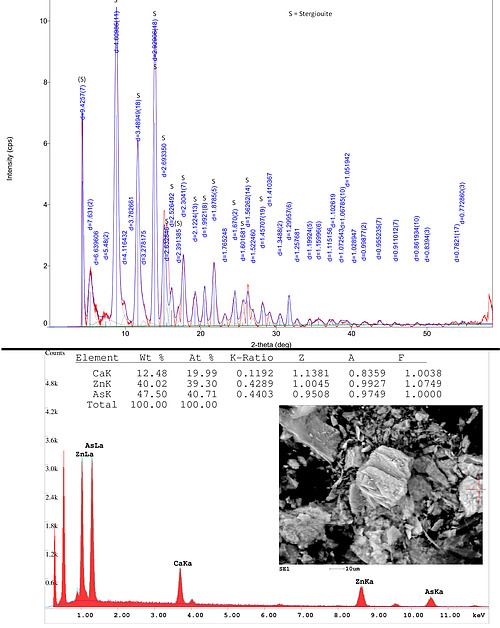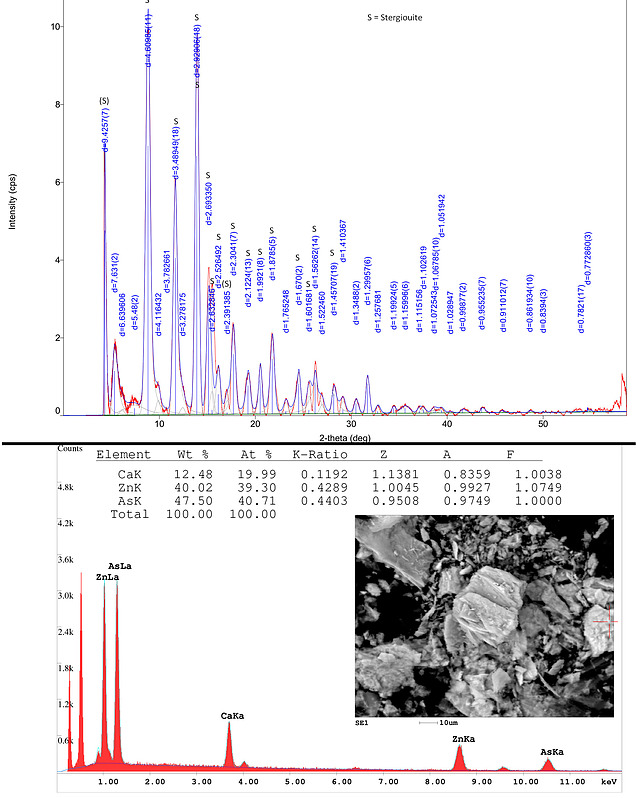Stergiouite
A valid IMA mineral species
This page is currently not sponsored. Click here to sponsor this page.
About Stergiouite
Formula:
CaZn2(AsO4)2 · 4H2O
Colour:
White to colourless
Lustre:
Pearly
Hardness:
3
Specific Gravity:
3.1
Crystal System:
Monoclinic
Name:
Named for Vasilis Stergiou (born 1958), in recognition of his contributions to the mineralogy of the Lavrion deposits.
Structurally related to phosphophyllite and hopeite group.
Chemically resembles prosperite, lotharmeyerite, gaitite, zincroselite and austinite.
Chemically resembles prosperite, lotharmeyerite, gaitite, zincroselite and austinite.
Unique Identifiers
Mindat ID:
53372
Long-form identifier:
mindat:1:1:53372:6
GUID
(UUID V4):
(UUID V4):
8c35a4f1-b7e1-4043-87cb-a415b5172c05
IMA Classification of Stergiouite
Approved
Approval year:
2019
First published:
2020
Classification of Stergiouite
8.CA.75
8 : PHOSPHATES, ARSENATES, VANADATES
C : Phosphates without additional anions, with H2O
A : With small and large/medium cations
8 : PHOSPHATES, ARSENATES, VANADATES
C : Phosphates without additional anions, with H2O
A : With small and large/medium cations
Mineral Symbols
As of 2021 there are now IMA–CNMNC approved mineral symbols (abbreviations) for each mineral species, useful for tables and diagrams.
| Symbol | Source | Reference |
|---|---|---|
| Sgo | IMA–CNMNC | Warr, L.N. (2021). IMA–CNMNC approved mineral symbols. Mineralogical Magazine, 85(3), 291-320. doi:10.1180/mgm.2021.43 |
Physical Properties of Stergiouite
Pearly
Colour:
White to colourless
Streak:
White
Hardness:
3 on Mohs scale
Tenacity:
Brittle
Cleavage:
Perfect
{100}
{100}
Fracture:
Irregular/Uneven
Density:
3.1(2) g/cm3 (Measured) 3.183 g/cm3 (Calculated)
Optical Data of Stergiouite
Type:
Biaxial (-)
RI values:
nα = 1.561(3) nβ = 1.619(3) nγ = 1.621(5)
Max Birefringence:
δ = 0.060

Image shows birefringence interference colour range (at 30µm thickness)
and does not take into account mineral colouration.
and does not take into account mineral colouration.
Surface Relief:
Moderate
Dispersion:
Very weak, with n(red) < n(violet).
Optical Extinction:
α is oriented approx. perpendicular to (100).
β is parallel to [010].
β is parallel to [010].
Pleochroism:
Not Visible
Chemistry of Stergiouite
Mindat Formula:
CaZn2(AsO4)2 · 4H2O
Crystallography of Stergiouite
Crystal System:
Monoclinic
Class (H-M):
m - Domatic
Space Group:
Pb
Setting:
Pc
Cell Parameters:
a = 9.4160(3) Å, b = 5.3000(3) Å, c = 10.8931(4) Å
β = 91.767(1)°
β = 91.767(1)°
Ratio:
a:b:c = 1.777 : 1 : 2.055
Unit Cell V:
543.36 ų (Calculated from Unit Cell)
Z:
2
Morphology:
The forms {100}, {100} are dominant, {010}, {001}, {001}, {101}, {101}, {101} and {101} are subordinate.
Twinning:
Type material - no twinning was observed but inversion twinning is inferred from the X-ray structure refinement.
X-Ray Powder Diffraction
Powder Diffraction Data:
| d-spacing | Intensity |
|---|---|
| 9.406 Å | (100) |
| 4.619 Å | (80) |
| 3.612 Å | (35) |
| 3.494 Å | (35) |
| 2.984 Å | (60) |
| 2.922 Å | (50) |
| 2.720 Å | (20) |
| 2.647 Å | (25) |
Geological Environment
Paragenetic Mode(s):
| Paragenetic Mode | Earliest Age (Ga) |
|---|---|
| Stage 7: Great Oxidation Event | <2.4 |
| 47a : [Near-surface hydration of prior minerals] | |
| 47d : [Arsenates, antimonates, selenates, bismuthinates] |
Type Occurrence of Stergiouite
General Appearance of Type Material:
Clusters of stacked, platy crystals. Individual plates rarely exceed 200 × 100 × 5 μm in size.
Place of Conservation of Type Material:
mineralogical collections of the Natural History Museum Vienna, Burgring 7, 1010 Vienna, Austria, inventory number O34.
Geological Setting of Type Material:
Oxidation of sphalerite and native arsenic and dissolution of surrounding calcite.
Reference:
Rieck, B., Giester, G., Lengauer, L.C., Chanmuang, C., Topa, D. (2020): Stergiouite, CaZn2(AsO4)2·4H2O – a new mineral from the Lavrion Mining District, Greece. Mineralogy and Petrology: 114: 319–327.
Synonyms of Stergiouite
Common Associates
Associated Minerals Based on Photo Data:
Related Minerals - Strunz-mindat Grouping
| 8.CA. | Davidlloydite | Zn3(AsO4)2 · 4H2O |
| 8.CA. | Apexite | NaMg(PO4) · 9H2O |
| 8.CA. | Brandãoite | BeAl2(PO4)2(OH)2(H2O)5 |
| 8.CA.05 | Fransoletite | Ca3Be2(PO4)2(PO3OH)2 · 4H2O |
| 8.CA.05 | Parafransoletite | Ca3Be2(PO4)2(PO3OH)2 · 4H2O |
| 8.CA.10 | Ehrleite | Ca4Be3Zn2(PO4)6 · 9H2O |
| 8.CA.15 | Faheyite | Be2Mn2+Fe3+2(PO4)4 · 6H2O |
| 8.CA.20 | Gainesite | Na(Na,K)(Be,Li)Zr2(PO4)4 · 1.5-2H2O |
| 8.CA.20 | Mccrillisite | NaCs(Be,Li)Zr2(PO4)4 · 1-2H2O |
| 8.CA.20 | Selwynite | NaK(Be,Al)Zr2(PO4)4 · 2H2O |
| 8.CA.25 | Pahasapaite | Li8(Ca,Li,K)10.5Be24(PO4)24 · 38H2O |
| 8.CA.30 | Hopeite | ZnZn2(PO4)2 · 4H2O |
| 8.CA.30 | Arsenohopeite | Zn3(AsO4)2 · 4H2O |
| 8.CA.30 | Nizamoffite | Mn2+Zn2(PO4)2(H2O)4 |
| 8.CA.30 | Unnamed (Mg-analogue of Hopeite) | Mg3(PO4)2 · 4H2O |
| 8.CA.35 | Warikahnite | Zn3(AsO4)2 · 2H2O |
| 8.CA.40 | Phosphophyllite | Zn2Fe(PO4)2 · 4H2O |
| 8.CA.42 | Steinmetzite | Zn2Fe3+(PO4)2(OH) · 3H2O |
| 8.CA.45 | Parascholzite | CaZn2(PO4)2 · 2H2O |
| 8.CA.45 | Scholzite | CaZn2(PO4)2 · 2H2O |
| 8.CA.50 | Keyite | Cu2+3Zn4Cd2(AsO4)6 · 2H2O |
| 8.CA.55 | Pushcharovskite | K0.6Cu18[AsO2(OH)2]4[AsO3OH]10(AsO4)(OH)9.6 · 18.6H2O |
| 8.CA.60 | Prosperite | Ca2Zn4(AsO4)4 · H2O |
| 8.CA.65 | Gengenbachite | KFe3+3(PO3OH)4[PO2(OH)2]2 · 6H2O |
| 8.CA.70 | Parahopeite | Zn3(PO4)2 · 4H2O |
| 8.CA.70 | Reaphookhillite | MgZn2(PO4)2 · 4H2O |
| 8.CA.80 | Limousinite | BaCa[Be4P4O16] · 6H2O |
| 8.CA.85 | Minjiangite | BaBe2(PO4)2 |
| 8.CA.85 | Wilancookite | (Ba5Li2◻)Ba6Be24P24O96 · 26H2O |
Fluorescence of Stergiouite
Not fluorescent
Other Information
Health Risks:
No information on health risks for this material has been entered into the database. You should always treat mineral specimens with care.
Internet Links for Stergiouite
mindat.org URL:
https://www.mindat.org/min-53372.html
Please feel free to link to this page.
Please feel free to link to this page.
Search Engines:
External Links:
Mineral Dealers:
References for Stergiouite
Reference List:
Miyawaki, Ritsuro, Hålenius, Ulf, Hatert, Frédéric, Pasero, Marco, Mills, Stuart J. (2019) IMA Commission on New Minerals, Nomenclature and Classification (CNMNC) NEWSLETTER 47. European Journal of Mineralogy, 31 (1) 197-202 doi:10.1127/ejm/2019/0031-2839
Localities for Stergiouite
Locality List
 - This locality has map coordinates listed.
- This locality has map coordinates listed.
 - This locality has estimated coordinates.
ⓘ - Click for references and further information on this occurrence.
? - Indicates mineral may be doubtful at this locality.
- This locality has estimated coordinates.
ⓘ - Click for references and further information on this occurrence.
? - Indicates mineral may be doubtful at this locality.
 - Good crystals or important locality for species.
- Good crystals or important locality for species.
 - World class for species or very significant.
(TL) - Type Locality for a valid mineral species.
(FRL) - First Recorded Locality for everything else (eg varieties).
- World class for species or very significant.
(TL) - Type Locality for a valid mineral species.
(FRL) - First Recorded Locality for everything else (eg varieties).
All localities listed without proper references should be considered as questionable.
Germany | |
| Stolze et al. (11/2020) |
Greece | |
| Rieck et al. (2020) |
| Branko Rieck collection |
| European Journal of Mineralogy +2 other references |
Quick NavTopAbout StergiouiteUnique IdentifiersIMA Classification Classification Mineral SymbolsPhysical Properties Optical Data Chemistry Crystallography X-Ray Powder DiffractionGeological EnvironmentType Occurrence SynonymsCommon AssociatesStrunz-MindatFluorescence Other InformationInternet Links References Localities Locality List






 symbol to view information about a locality.
The
symbol to view information about a locality.
The 



Uranus Mine, Kleinrückerswalde, Annaberg-Buchholz, Erzgebirgskreis, Saxony, Germany